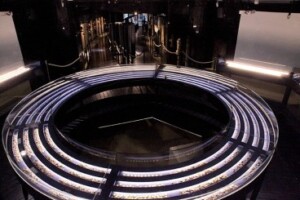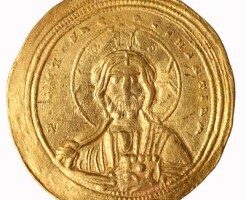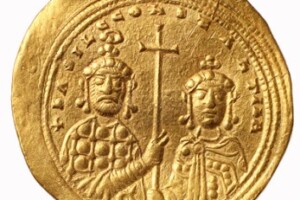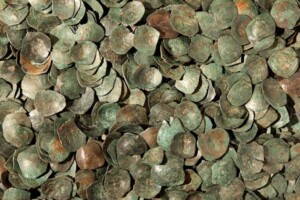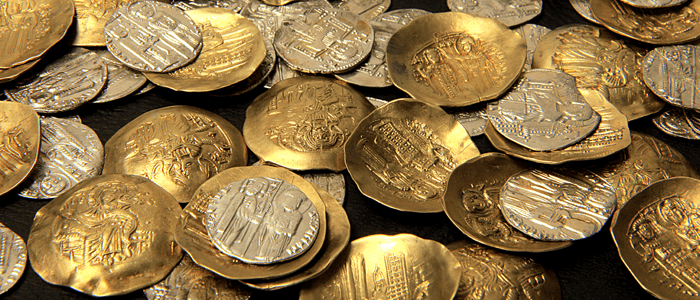
The medieval collection of the Archaeological Museum of Macedonia is represented by coins of emperors and rulers during a period of a thousand years, beginning with the reign of Anastasius I (491-518), specifically from his monetary reform in 498, until the collapse of the monetary system of the independent rulers in the late XIV century. Monetary reform was introduced in copper coins in 498; this date is generally accepted as the beginning of Early Byzantine monetary history, which helped to reform the already worn out monetary system and to prevent hyperinflation. The period after the reform was one of economic recovery, but also a time of turbulent military events in the Balkans, with a strong emphasis on Macedonia. As a result, the Byzantine army was very present, as well as the commercial activities that followed the war, all of which led to the discovery of an enormous amount of numismatic material consisting of Early Byzantine coins.
The steady monetary policy, which Byzantium was trying to implement on its territory, did not cause drastic changes in Macedonia between the VII and X centuries, because the circulation of money was at a very low level. This situation resulted from the permanent settlement of the Slavic and Avar tribes from the north, whose economy was still based on natural exchange. The coastal cities provided an exception; among them were the two largest coin-minting centers of Constantinople and Thessalonica, which produced money throughout the whole medieval period.
The weak monetarization of the Balkans lasted until the time of Basil II, who succeeded in re-imposing control by Byzantium over the peninsula and through inflationary bronze emissions increased monetary circulation, which experienced its culmination during the Comnenus dynasty. The anonymous folles, minted between 976 and 1092, were propaganda coins with a political background, and their main purpose was to impose Byzantine monetary policy in the territories that did not completely accept Byzantine central authority. These modified coins have Christian messages on the obverse and reverse sides; they do not show any state insignia or symbols. In addition to the bronze coins, in the period between the VII and XI centuries, there was a significant presence of gold (solidi and histamena) and silver coins (miliaresia), which are mostly found in hoards.
The next major reform of the Byzantine monetary system was made by the emperor Alexius I Comnenus in 1092; during this reform the coin completely lost its usual form and became concave. Because the period from the XI to XIII century in Macedonia was a turbulent one, both militarily and monetarily, as a result an enormous amount of numismatic material was found in hoards and as single examples. The largest concentration of coins in the medieval collection of the Archaeological Museum of Macedonia originates from this period. Present here in large number are coins of Manuel I Komnenus, Isaac I Angelus, Latin and Bulgarian imitations, coins of rulers of Nicaea and Thessalonica. In addition to those, present in large quantity are examples from the last Byzantine dynasty, which existed on the territory of Macedonia until the arrival of the Serbs or, in other words, the Palaiologos dynasty, which is represented by coins of Michael VIII, Andronikos II and his grandson Andronikos III.
The change of political authority in Macedonia, from 1282 until the fall of Skopje to the Ottomans a hundred years later, caused a change also in the monetary system; concave coins, minted from gold, electrum, and bronze, were abandoned and exchanged for flat coins based on the West European (Venetian) mono-metallic policy of silver. From this period we have a surprisingly large number of hoards discovered throughout the territory of Macedonia; in the hoards are present examples from all the Serbian rulers, as well as from independent rulers such as Volkashin, Marco, Constantin, Dragash, Andria Gropa and Lazar.
From the end of the XIII until the end of the XVII century on the territory of Macedonia coins were present that belonged to the great commercial powers of that time such as Venice, Hungary and Dubrovnik; these coins indicate the strong economic and commercial dynamic. In addition to these, we can add numerous hoards and single examples of akçes, mangirs and other denominations from the Ottoman period, which they used to impose their monetary policy on the Balkan Peninsula from the end of the XIV century to the reign of the last Sultan Mehmed V Reshad (1909- 1918).
The Medieval numismatic collection of the Archaeological Museum of Macedonia is the second largest in the country, after the collection in Ohrid.
M.A. Trajan Zafirovski, numismatist, senior curator.
trajanzafirovski@yahoo.com

